Surface Modification of Diatomite-Based Micro-Arc Coatings for Magnesium Implants Using a Low-Energy High-Current Electron Beam Processing Technique
Abstract
1. Introduction
2. Materials and Methods
2.1. Sample Preparation
2.2. Sample Modification
2.3. Sample Characterization
2.4. Biological Studies
3. Results
3.1. Morphology of the Coatings
3.2. Elemental and Phase Composition
3.3. Mechanical Properties
3.4. Corrosion and Biological Properties
3.4.1. Electrochemical Properties
3.4.2. Immersion in Simulated Body Fluid (SBF)
3.4.3. In Vitro Cytotoxicity
3.4.4. Assessment of Lipid Peroxidation
4. Discussion
5. Conclusions
Author Contributions
Funding
Data Availability Statement
Acknowledgments
Conflicts of Interest
References
- Heimann, R.B. Magnesium alloys for biomedical application: Advanced corrosion control through surface coating. Surf. Coat. Technol. 2021, 405, 126521. [Google Scholar] [CrossRef]
- Tsakiris, V.; Tardei, C.; Clicinschi, F.M. Biodegradable Mg alloys for orthopedic implants—A review. J. Magnes. Alloy. 2021, 9, 1884–1905. [Google Scholar] [CrossRef]
- Raman, R.K.; Harandi, S.E. Resistance of magnesium alloys to corrosion fatigue for biodegradable implant applications: Current status and challenges. Materials 2017, 10, 1316. [Google Scholar] [CrossRef] [PubMed]
- Comba, A.; Cicek, B.; Comba, B.; Sancak, T.; Akveran, G.A.; Sun, Y.; Elen, L.; Afshar, M.T. Investigation of in-vitro biocompatibility and in-vivo biodegradability of AM series Mg alloys. Mater. Technol. 2022, 37, 2819–2831. [Google Scholar] [CrossRef]
- Kamrani, S.; Fleck, C. Biodegradable magnesium alloys as temporary orthopaedic implants: A Review. BioMetals 2019, 32, 185–193. [Google Scholar] [CrossRef] [PubMed]
- Maier, P.; Hort, N. Magnesium alloys for biomedical applications. Metals 2020, 10, 1328. [Google Scholar] [CrossRef]
- Saha, S.; Lestari, W.; Dini, C.; Sarian, M.N.; Hermawan, H.; Barão, V.A.R.; Sukotjo, C.; Takoudis, C. Corrosion in Mg-alloy biomedical implants—The strategies to reduce the impact of the corrosion inflammatory reaction and microbial activity. J. Magnes. Alloy. 2022, 10, 3306–3326. [Google Scholar] [CrossRef]
- Molaei, M.; Fattah-alhosseini, A.; Nouri, M.; Nourian, A. Systematic optimization of corrosion, bioactivity, and biocompatibility behaviors of calcium-phosphate plasma electrolytic oxidation (PEO) coatings on titanium substrates. Ceram. Int. 2022, 48, 6322–6337. [Google Scholar] [CrossRef]
- Darband, G.B.; Aliofkhazraei, M.; Hamghalam, P.; Valizade, N. Plasma electrolytic oxidation of magnesium and its alloys: Mechanism, properties and applications. J. Magnes. Alloy. 2017, 5, 74–132. [Google Scholar] [CrossRef]
- Wala, M.; Łubiarz, D.; Waloszczyk, N.; Simka, W. Plasma electrolytic oxidation of titanium in Ni and Cu hydroxide suspensions towards preparation of electrocatalysts for urea oxidation. Materials 2023, 16, 2191. [Google Scholar] [CrossRef]
- Santos-Coquillat, A.; Esteban-Lucia, M.; Martinez-Campos, E.; Mohedano, M.; Arrabal, R.; Blawert, C.; Zheludkevich, M.L.; Matykina, E. PEO coatings design for Mg-Ca alloy for cardiovascular stent and bone regeneration applications. Mater. Sci. Eng. C 2019, 105, 110026. [Google Scholar] [CrossRef]
- Ghasemi, A.; Kamrani, S.; Hübler, D.; Fleck, C. Corrosion behavior of porous magnesium coated by plasma electrolytic oxidation in simulated body fluid. Mater. Corros. 2019, 70, 1561–1569. [Google Scholar] [CrossRef]
- Liu, S.; Li, Z.; Yu, Q.; Qi, Y.; Peng, Z.; Liang, J. Dual self-healing composite coating on magnesium alloys for corrosion protection. Chem. Eng. J. 2021, 424, 130551. [Google Scholar] [CrossRef]
- Grebņevs, V.; Leśniak-Ziółkowska, K.; Wala, M.; Dulski, M.; Altundal, Ș.; Dutovs, A.; Avotiņa, L.; Erts, D.; Viter, R.; Vīksna, A.; et al. Modification of physicochemical properties and bioactivity of oxide coatings formed on Ti substrates via plasma electrolytic oxidation in crystalline and amorphous calcium phosphate particle suspensions. Appl. Surf. Sci. 2022, 598, 153793. [Google Scholar] [CrossRef]
- Prosolov, K.A.; Lastovka, V.V.; Belyavskaya, O.A.; Lychagin, D.V.; Schmidt, J.; Sharkeev, Y.P. Tailoring the surface morphology and the crystallinity state of Cu- and Zn-substituted hydroxyapatites on Ti and Mg-based alloys. Materials 2020, 13, 4449. [Google Scholar] [CrossRef]
- Sasikumar, Y.; Kumar, A.M.; Babu, R.S.; Rahman, M.M.; Samyn, L.M.; de Barros, A.L.F. Biocompatible hydrophilic brushite coatings on AZX310 and AM50 alloys for orthopaedic implants. J. Mater. Sci. Mater. Medic. 2018, 29, 123. [Google Scholar] [CrossRef]
- Shadanbaz, S.; Dias, G.J. Calcium phosphate coatings on magnesium alloys for biomedical applications: A Review. Acta Biomater. 2012, 8, 20–30. [Google Scholar] [CrossRef]
- Molaei, M.; Nouri, M.; Babaei, K.; Fattah-Alhosseini, A. Improving surface features of PEO coatings on titanium and titanium alloys with zirconia particles: A review. Surf. Interfaces 2021, 22, 100888. [Google Scholar] [CrossRef]
- Fattah-alhosseini, A.; Chaharmahali, R.; Babaei, K. Effect of particles addition to solution of plasma electrolytic oxidation (PEO) on the properties of PEO coatings formed on magnesium and its alloys: A review. J. Magnes. Alloy. 2020, 8, 799–818. [Google Scholar] [CrossRef]
- Kashin, A.D.; Sedelnikova, M.B.; Chebodaeva, V.V.; Uvarkin, P.V.; Luginin, N.A.; Dvilis, E.S.; Kazmina, O.V.; Sharkeev, Y.P.; Khlusov, I.A.; Miller, A.A.; et al. Diatomite-based ceramic biocoating for magnesium implants. Ceram. Int. 2022, 48, 28059–28071. [Google Scholar] [CrossRef]
- Fu, Q.; Liu, Q.; Li, L.; Li, X.; Gu, H.; Sheng, B. Effect of doping different Si source on Ca-P bioceramic coating fabricated by laser cladding. J. Appl. Biomater. Funct. Mater. 2020, 18, 1–9. [Google Scholar] [CrossRef]
- Mohammadi, H.; Hafezi, M.; Nezafati, N.; Heasarki, S.; Nadernezhad, A.; Ghazanfari, S.M.H.; Sepantafar, M. Bioinorganics in bioactive calcium silicate ceramics for bone tissue repair: Bioactivity and biological properties. J. Ceram. Sci. Technol. 2014, 5, 1–12. [Google Scholar]
- Pan, Y.; Chen, C.; Wang, D.; Huang, D. Dissolution and precipitation behaviors of silicon-containing ceramiccoating on Mg–Zn–Ca alloy in simulated body fluid. Colloids Surf. B Biointerfaces 2014, 122, 746–751. [Google Scholar] [CrossRef]
- Sainz, M.A.; Pena, P.; Serena, S.; Caballero, A. Influence of design on bioactivity of novel CaSiO3–CaMg(SiO3)2 bioceramics: In vitro simulated body fluid test and thermodynamic simulation. Acta Biomater. 2010, 6, 2797–2807. [Google Scholar] [CrossRef]
- Ni, S.; Chang, J.; Chou, L.; Zhai, W. Comparison of osteoblast-like cell responses to calcium silicate and tricalcium phosphate ceramics in vitro. J. Biomed. Mater. Res. Part B Appl. Biomater. 2007, 80, 174–183. [Google Scholar] [CrossRef] [PubMed]
- Bakhsheshi-Rad, H.R.; Najafinezhad, A.; Hamzah, E.; Ismail, A.F.; Berto, F.; Chen, X. Clinoenstatite/Tantalum Coating for Enhancement of Biocompatibility and Corrosion Protection of Mg Alloy. J. Funct. Biomater. 2020, 11, 26. [Google Scholar] [CrossRef] [PubMed]
- Proskurovsky, D.I.; Rotshtein, V.P.; Ozur, G.E.; Markov, A.B.; Nazarov, D.S.; Shulov, V.A.; Ivanov, Y.F.; Buchheit, R.G. Pulsed electron-beam technology for surface modification of metallic materials. J. Vac. Sci. Technol. A. 1998, 16, 2480–2488. [Google Scholar] [CrossRef]
- Proskurovsky, D.I.; Rotshtein, V.P.; Ozur, G.E.; Ivanov, Y.F.; Markov, A.B. Physical foundations for surface treatment of materials with low energy, high current electron beams. Surf. Coat. Technol. 2000, 125, 49–56. [Google Scholar] [CrossRef]
- Pfeifenberger, M.J.; Milassin, G.; Hohenwarter, A.; Putz, B.; Semprimoschnig, C.O.A.; Pippan, R. Electron irradiation effects on strength and ductility of polymer foils studied by femtosecond laser-processed micro-tensile specimens. Materials 2019, 12, 1468. [Google Scholar] [CrossRef]
- Yu, B.-H.; Ovcharenko, V.E.; Ivanov, K.V.; Mokhovikov, A.A.; Zhao, Y.-H. Effect of surface layer structural-phase modification on tribological and strength properties of a TiC–(Ni–Cr) Metal Ceramic Alloy. Acta Metall. Sin. 2018, 31, 547–551. [Google Scholar] [CrossRef]
- Ozur, G.; Proskurovsky, D.; Rotshtein, V.; Markov, A. Production and application of low-energy, high-current electron beams. Laser Part. Beams 2003, 21, 157–174. [Google Scholar] [CrossRef]
- Ozur, G.E.; Proskurovsky, D.I. Generation of low-energy high-current electron beams in plasma-anode electron guns. Plasma Phys. Rep. 2018, 44, 18–39. [Google Scholar] [CrossRef]
- Sedelnikova, M.B.; Ivanov, K.V.; Ugodchikova, A.V.; Kashin, A.D.; Uvarkin, P.V.; Sharkeev, Y.P.; Tolkacheva, T.V.; Tolmachev, A.I.; Schmidt, J.; Egorkin, V.S.; et al. The effect of pulsed electron irradiation on the structure, phase composition, adhesion and corrosion properties of calcium phosphate coating on Mg0.8Ca alloy. Mater. Chem. Phys. 2023, 294, 126996. [Google Scholar] [CrossRef]
- Węglowski, M.S.; Śliwiński, P.; Dymek, S.; Kalemba-Rec, I.; Kapuściński, M.; Wrona, A.; Kustra, K. A comprehensive study on the microstructure of plasma spraying coatings after electron beam remelting. J. Phys. Conf. Ser. 2023, 2443, 012005. [Google Scholar] [CrossRef]
- Ivanov, K.V.; Voronov, A.V. Evolution of morphology, microstructure and phase composition of zirconia thin coating on copper as a result of low energy high current pulsed electron beam irradiation. Surf. Coat. Technol. 2023, 456, 129257. [Google Scholar] [CrossRef]
- Kokubo, T.; Takadama, H. How useful is SBF in predicting in vivo bone bioactivity? Biomaterials 2006, 27, 2907–2915. [Google Scholar] [CrossRef] [PubMed]
- Janero, D.R. Malondialdehyde and thiobarbituric acid-reactivity as diagnostic indices of lipid peroxidation and peroxidative tissue injury. Free Radic. Biol. Med. 1990, 9, 515–540. [Google Scholar] [CrossRef]
- Hinton, R.H.; Burge, M.L.E.; Hartman, G.C. Sucrose interference in the assay of enzymes and protein. Anal. Biochem. 1969, 29, 248–256. [Google Scholar] [CrossRef]
- Akram, W.; Zahid, R.; Usama, R.M.; AlQahtani, S.A.; Dahshan, M.; Basit, M.A.; Yasir, M. Enhancement of antibacterial properties, surface morphology and in vitro bioactivity of hydroxyapatite-zinc oxide nanocomposite coating by electrophoretic deposition technique. Bioengineering 2023, 10, 693. [Google Scholar] [CrossRef]
- ISO 10993-5:2009; Biological Evaluation of Medical Devices. Part 5: Tests for In Vitro Cytotoxicity. International Organization for Standardization: Geneva, Switzerland, 2022.
- Yang, H.; Zhou, M.; Li, H.; Wei, T.; Tang, C.; Zhou, Y.; Long, X. Effects of low-level lipid peroxidation on the permeability of nitroaromatic molecules across a membrane: A computational study. ACS Omega 2020, 5, 4798–4806. [Google Scholar] [CrossRef]
- Lisanti, M.P.; Martinez-Outschoorn, U.E.; Lin, Z.; Pavlides, S.; Whitaker-Menezes, D.; Pestell, R.G.; Howell, A.; Sotgia, F. Hydrogen peroxide fuels aging, inflammation, cancer metabolism and metastasis: The seed and soil also needs “fertilizer”. Cell Cycle 2011, 10, 2440–2449. [Google Scholar] [CrossRef]
- Glorieux, C.; Calderon, P.B. Catalase, a remarkable enzyme: Targeting the oldest antioxidant enzyme to find a new cancer treatment approach. Biol. Chem. 2017, 398, 1095–1108. [Google Scholar] [CrossRef]
- Aliofkhazraei, M.; Macdonald, D.D.; Matykina, E.; Parfenov, E.V.; Egorkin, V.S.; Curran, J.A.; Troughton, S.C.; Sinebryukhov, S.L.; Gnedenkov, S.V.; Lampke, T.; et al. Review of plasma electrolytic oxidation of titanium substrates: Mechanism, properties, applications and limitations. Appl. Surf. Sci. Adv. 2021, 5, 100121. [Google Scholar] [CrossRef]
- Simchen, F.; Sieber, M.; Kopp, A.; Lampke, T. Introduction to plasma electrolytic oxidation—An overview of the process and applications. Coatings 2020, 10, 628. [Google Scholar] [CrossRef]
- Polunin, A.V.; Cheretaeva, A.O.; Borgardt, E.D.; Rastegaev, I.A.; Krishtal, M.M.; Katsman, A.V.; Yasnikov, I.S. Improvement of oxide layers formed by plasma electrolytic oxidation on cast Al–Si alloy by incorporating TiC nanoparticles. Surf. Coat. Technol. 2021, 423, 127603. [Google Scholar] [CrossRef]
- He, J.; Zhang, B.; Shao, L.; Feng, W.; Jiang, L.; Zhao, B. Biomechanical and histological studies of the effects of active zinc-coated implants by plasma electrolytic oxidation method on osseointegration in rabbit osteoporotic jaw. Surf. Coat. Technol. 2020, 396, 125848. [Google Scholar] [CrossRef]
- Kim, S.Y.; Kim, Y.K.; Ryu, M.H.; Bae, T.S.; Lee, M.H. Corrosion resistance and bioactivity enhancement of MAO coated Mg alloy depending on the time of hydrothermal treatment in Ca-EDTA solution. Sci. Rep. 2017, 7, 9061. [Google Scholar] [CrossRef] [PubMed]
- Chebodeva, V.V.; Komarova, E.G.; Erofeev, M.V.; Ripenko, V.S.; Sharkeev, Y.P. Effect of UV irradiation and diffuse plasma on surface properties of micro-arc calcium phosphate coatings. J. Phys. Conf. Ser. 2019, 1393, 012077. [Google Scholar] [CrossRef]
- Qin, Y.; Dong, C.; Wang, X.; Hao, S.; Wu, A.; Zou, J.; Liu, Y. Temperature profile and crater formation induced in high-current pulsed electron beam processing. J. Vac. Sci. Technol. A 2003, 21, 1934–1938. [Google Scholar] [CrossRef]
- Dun, A.; Wei, J.; Gan, F. Marangoni effect induced micro/nano-patterning on Sb2Te3 phase change thin film by laser pulse. Appl. Phys. A. 2011, 103, 139–147. [Google Scholar] [CrossRef]
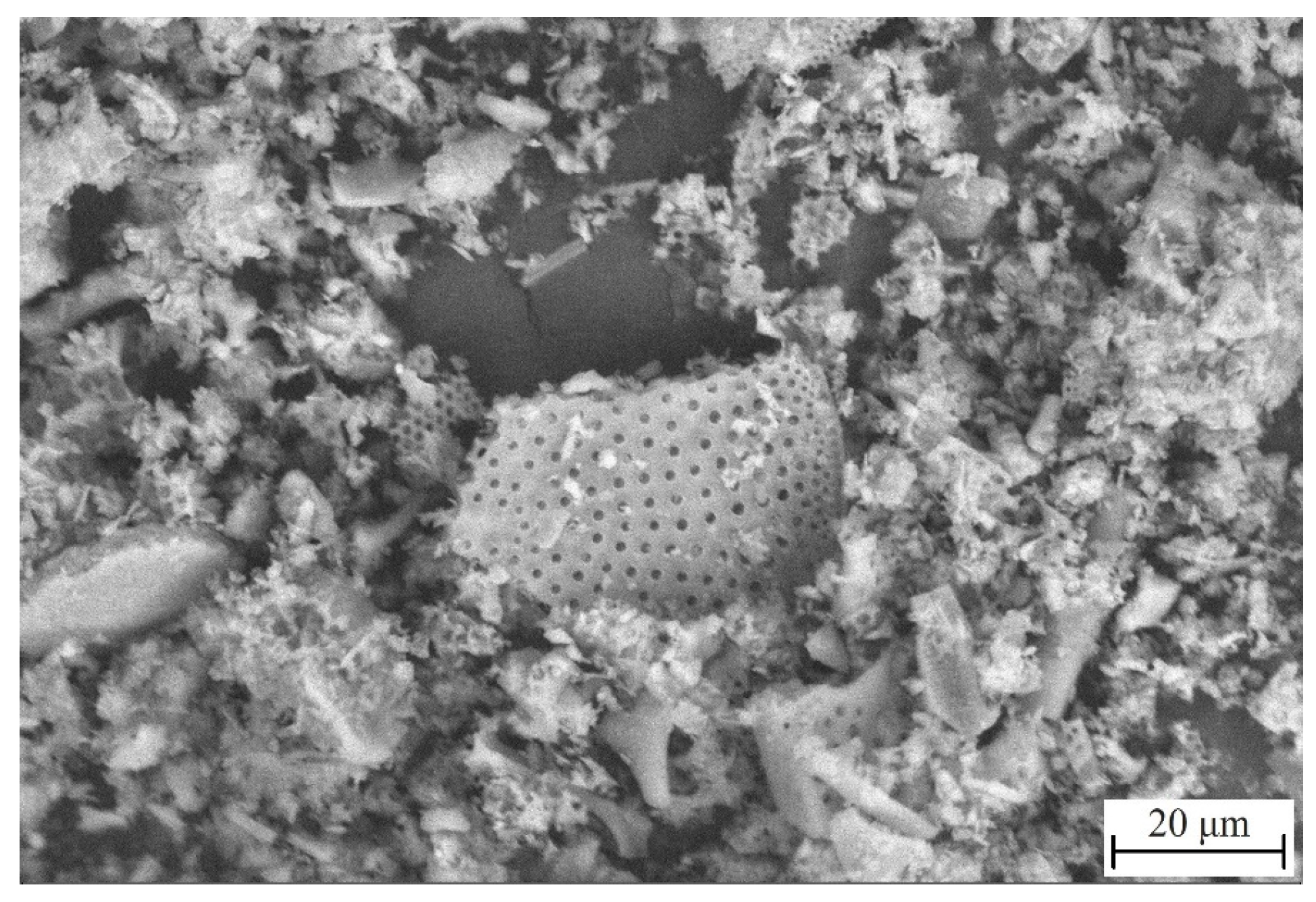


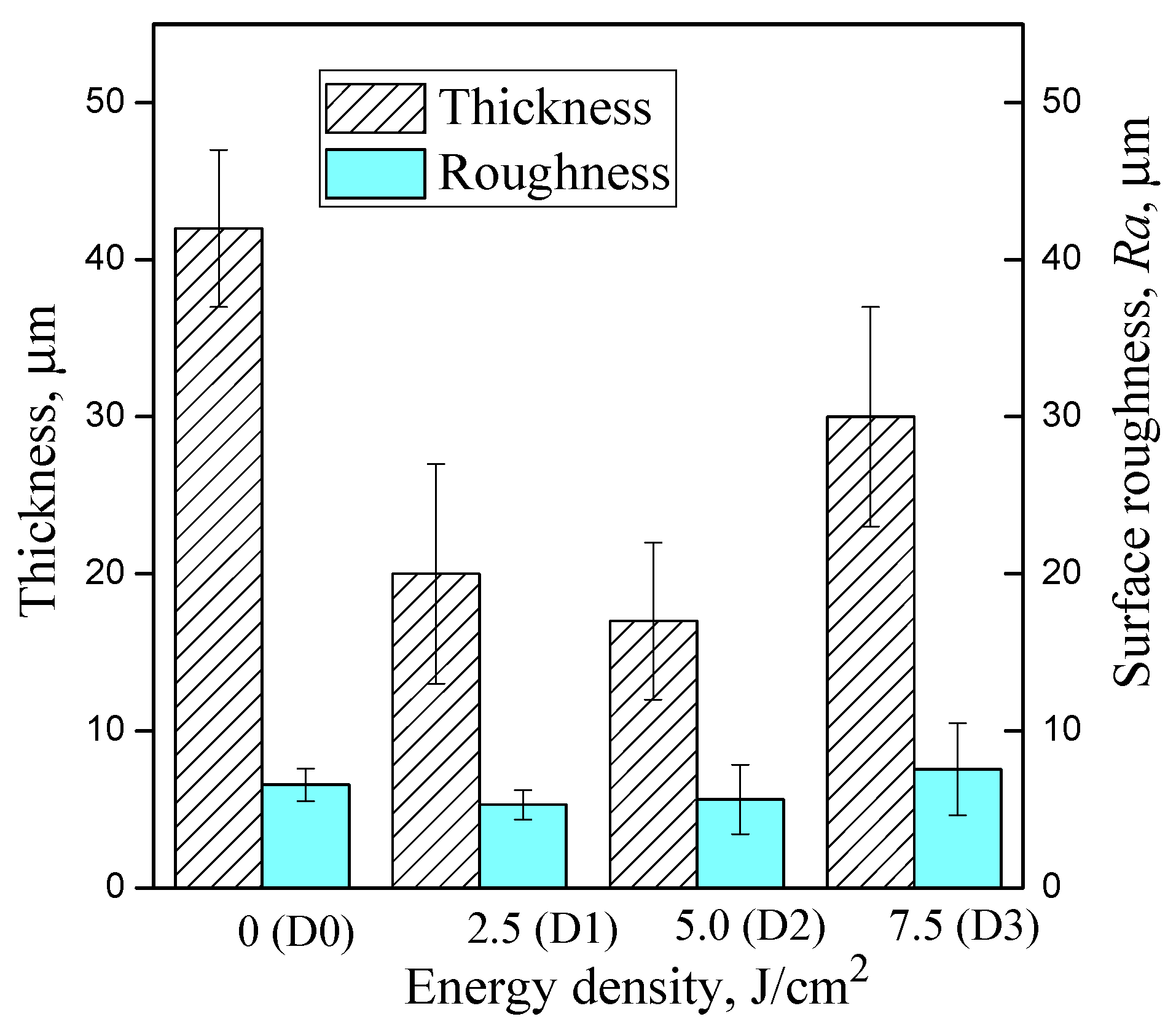
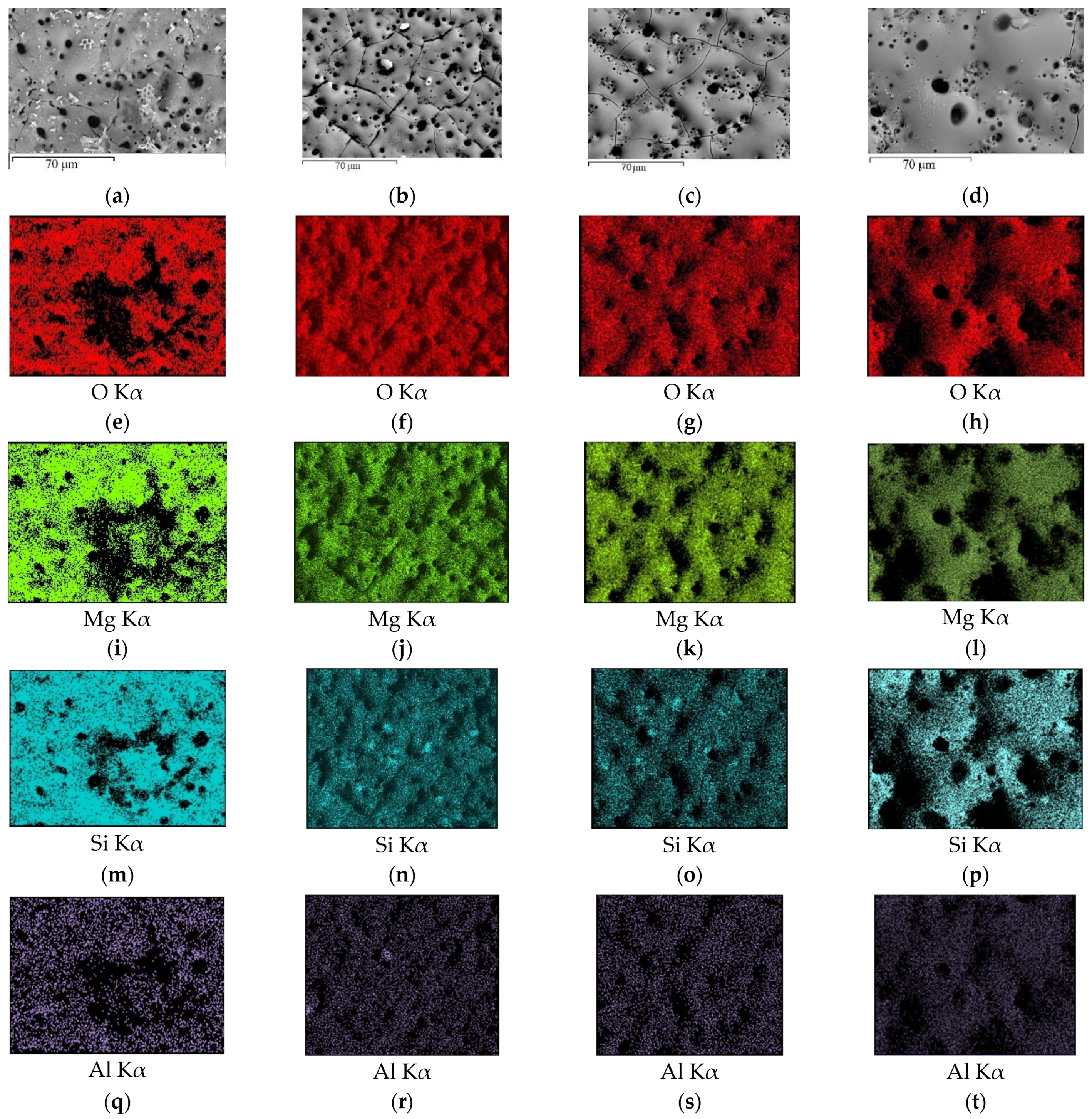

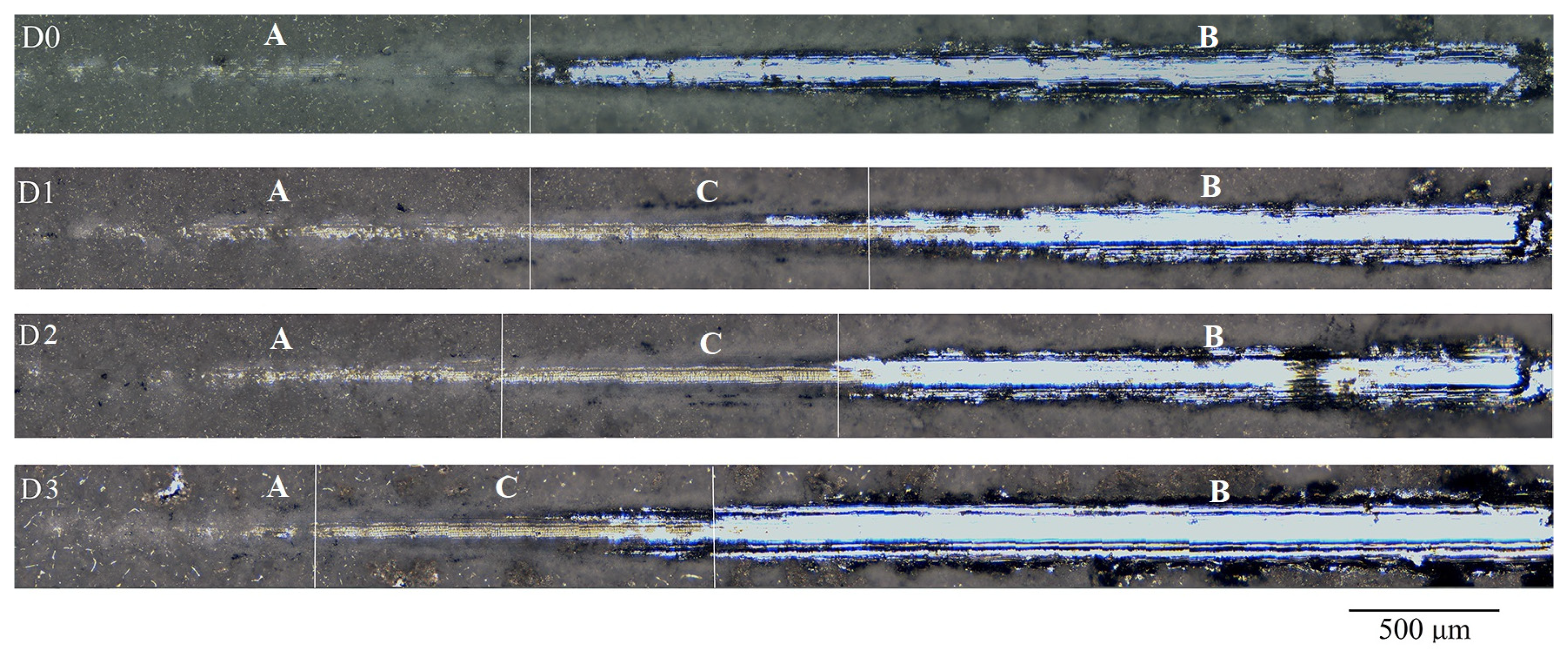
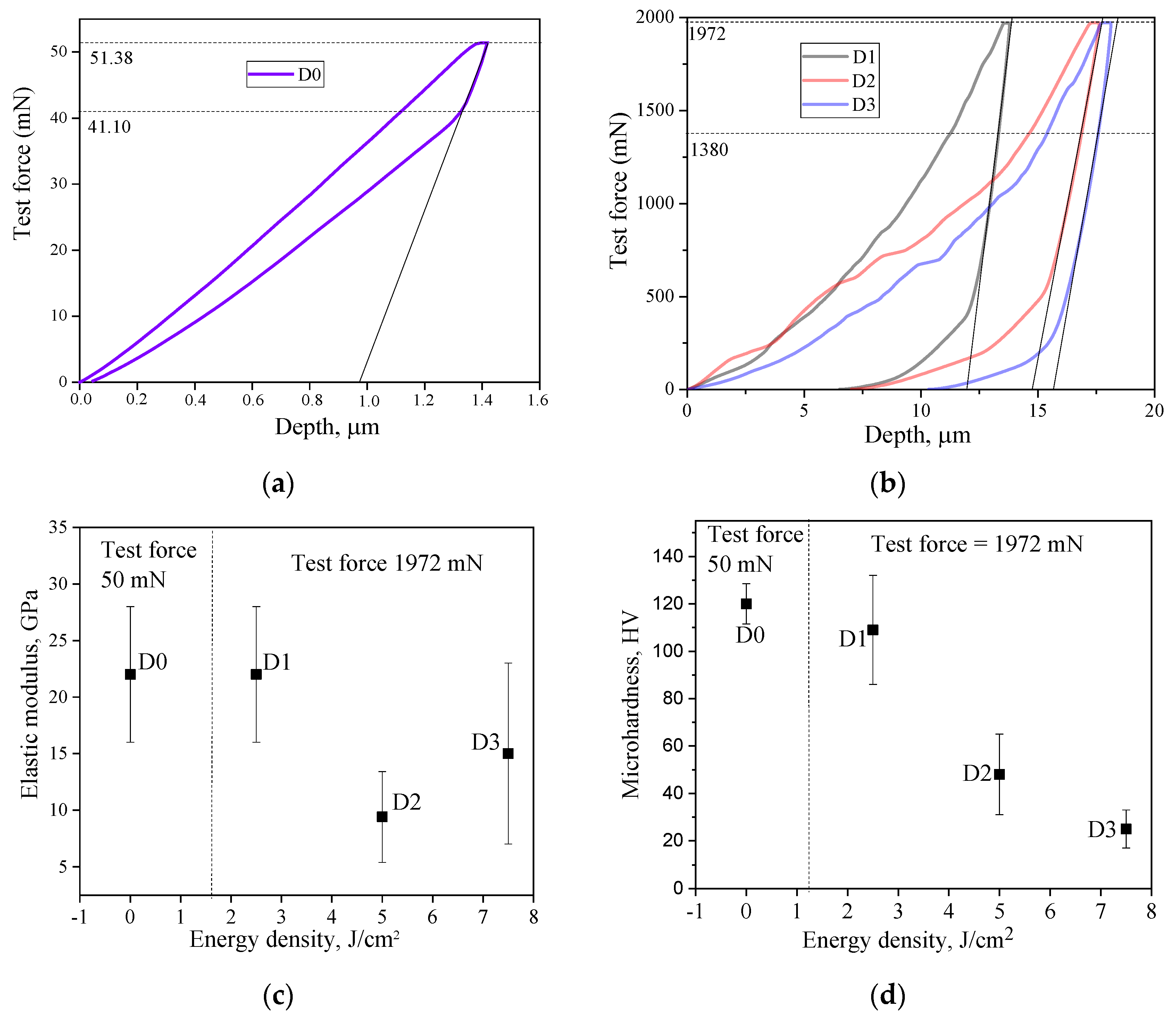

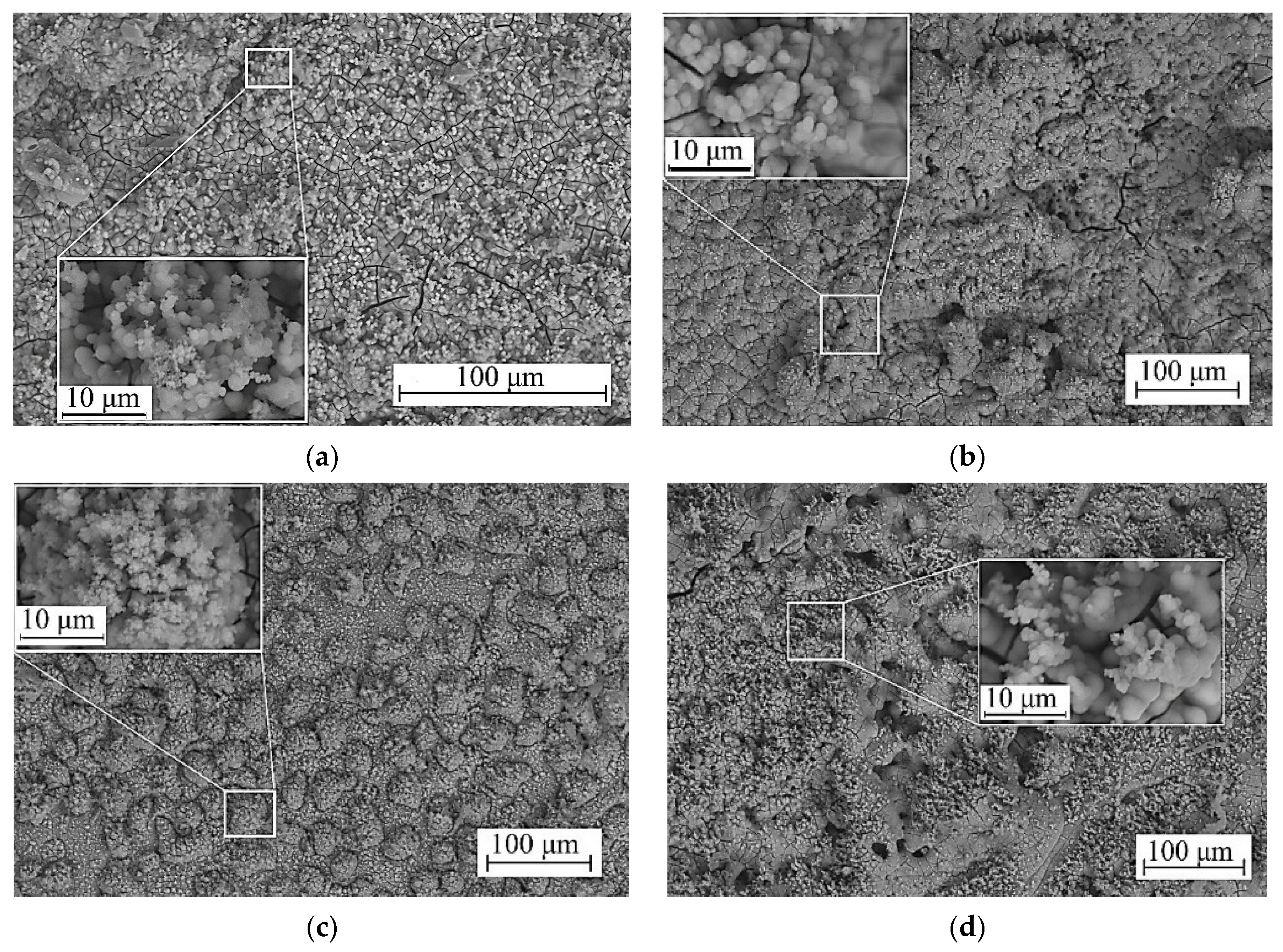

| Sample Number | Voltage of MAO Process, V | Duration of MAO Process, Min | Energy Density of LEHCEB, J/cm2 | Number of Pulses |
|---|---|---|---|---|
| D0 | 400 | 5 | – | – |
| D1 | 400 | 5 | 2.5 | 5 |
| D2 | 400 | 5 | 5 | 5 |
| D3 | 400 | 5 | 7.5 | 5 |
| Elements | D0 | D1 | D2 | D3 |
|---|---|---|---|---|
| O Kα | 61.7 ± 0.1 | 60.0 ± 0.4 | 59.5 ± 0.9 | 55.4 ± 0.1 |
| Na Kα | 1.6 | 0.0 | 0.0 | 0.4 |
| Mg Kα | 16.0 ± 0.09 | 23.6 ± 0.2 | 26.2 ± 0.2 | 27.1 ± 0.1 |
| Al Kα | 1.0 | 1.5 | 1.5 | 1.0 |
| Si Kα | 19.3 ± 0.07 | 14.5 ± 0.1 | 13.8 ± 0.1 | 15.5 ± 0.5 |
| K Kα | 0.1 | 0.03 | 0.0 | 0.02 |
| Ca Kα | 0.2 | 0.1 | 0.1 | 0.04 |
| Fe Kα | 0.3 | 0.2 | 0.1 | 0.6 |
| Elements | D0 | D1 | D2 | D3 |
|---|---|---|---|---|
| O Kα | 62.8 ± 0.1 | 59.1 ± 0.1 | 59.8 ± 0.7 | 60.03 ± 0.8 |
| Na Kα | 0.1 | 0.6 | 0.15 | 0.63 |
| Mg Kα | 17.9 ± 0.07 | 24.1 ± 0.05 | 23.6 ± 0.08 | 24.64 ± 0.09 |
| Al Kα | 1.3 | 1.0 | 1.1 | 0.97 |
| Si Kα | 17.5 ± 0.03 | 15.0 ± 0.07 | 15.2 ± 0.03 | 13.53 ± 0.08 |
| K Kα | 0.12 | 0.15 | 0.16 | 0.03 |
| Ca Kα | 0.07 | 0.04 | 0.04 | 0.1 |
| Fe Kα | 0.37 | 0.05 | 0.05 | 0.07 |
| Sample | Scratch Number | Critical Load, N | Average Critical Load, N |
|---|---|---|---|
| D0 | 1 | 7.25 | 7.6 ± 0.3 |
| 2 | 7.28 | ||
| 3 | 8.23 | ||
| D1 | 1 | 20.08 | 18.8 ± 0.65 |
| 2 | 17.62 | ||
| 3 | 18.61 | ||
| D2 | 1 | 18.89 | 17.1 ± 1.2 |
| 2 | 17.34 | ||
| 3 | 15.06 | ||
| D3 | 1 | 12.87 | 13.3 ± 0.3 |
| 2 | 13.97 | ||
| 3 | 13.08 |
| Sample | Ec, V | Jc, A·cm−2 | Rp, Ω·cm2 |
|---|---|---|---|
| Mg alloy | −1.42 | 5.7 × 10−5 | 1.7 × 103 |
| D0 | −0.98 | 1.8 × 10−7 | 8.8 × 104 |
| D1 | −0.16 | 7.3 × 10−8 | 1.1 × 106 |
| D2 | −0.51 | 4.6 × 10−10 | 1.4 × 108 |
| D3 | −0.29 | 2.8 × 10−8 | 1.8 × 106 |
| Elements | D0 | D1 | D2 | D3 |
|---|---|---|---|---|
| O Kα | 62.8 ± 1.5 | 68.9 ± 1.4 | 66.7 ± 1.9 | 71.8 ± 0.7 |
| Mg Kα | 10.4 ± 0.2 | 6.5 ± 0.9 | 12.2 ± 1.9 | 5.5 ± 0.5 |
| Si Kα | 2.7 ± 0.2 | 0.8 ± 0.2 | 0.15 | 0.3 ± 0.1 |
| P Kα | 9.0 ± 0.2 | 8.9 ± 0.3 | 8.3 ± 0.1 | 8.8 ± 0.2 |
| Ca Kα | 12.9 ± 0.3 | 14.9 ± 0.5 | 13.7 ± 0.1 | 13.6 ± 0.4 |
| Ca/P | 1.43 | 1.67 | 1.65 | 1.54 |
| Indicator | D0 | D2 | Control |
|---|---|---|---|
| MDA, induced, mcmole/mg protein | 94.79 (65.41; 124.17) | 85.61 (27.09; 144.16) | 72.40 (54.95; 89.86) |
| Catalase, mmol/mg | 0.31 (0.21; 0.41) | 0.48 (0.19; 0.76) | 0.36 (0.25; 0.47) |
| TBA products, in the spontaneous condition mmol/mg protein | 95.29 (58.37; 132.22) | 83.41 (47.72; 119,1) | 67.80 (62.02; 73.58) |
| TBA products, induced, mmol/mg protein | 127.75 (81.81; 173.71) * | 63.09 (62.65; 63.55) * | 48.44 (42.15; 54.72) |
| SOD, units/mg protein | 1.39 (0.85; 1.95) | 2.11 (1.69; 2.53) | 1.96 (1.9; 2.02) |
| Bityrosine, units/mg protein | 0.05 (0.04; 0.05) * | 0.02 (0.01; 0.03) | 0.01 (0.001; 0.02) |
| Cathepsin D free, nmole/mg protein | 20.15 (13.49; 26.81) | 28.18 (27.36; 29.02) | 21.8 (4.63; 38.97) |
| Cathepsin D total, nmole/mg protein | 419.73 (371.44; 468.01) * | 400.66 (298.82; 502.49) | 350.31 (332.08; 368.55) |
| Cathepsin D free/Cathepsin D total | 0.05 (0.03; 0.07) | 0.07 (0.06; 0.09) | 0.06 (0.01; 0.12) |
Disclaimer/Publisher’s Note: The statements, opinions and data contained in all publications are solely those of the individual author(s) and contributor(s) and not of MDPI and/or the editor(s). MDPI and/or the editor(s) disclaim responsibility for any injury to people or property resulting from any ideas, methods, instructions or products referred to in the content. |
© 2024 by the authors. Licensee MDPI, Basel, Switzerland. This article is an open access article distributed under the terms and conditions of the Creative Commons Attribution (CC BY) license (https://creativecommons.org/licenses/by/4.0/).
Share and Cite
Sedelnikova, M.B.; Kashin, A.D.; Bakina, O.V.; Uvarkin, P.V.; Luginin, N.A.; Sharkeev, Y.P.; Khimich, M.A.; Kazmina, O.V.; Dvilis, E.S.; Ivanov, K.V. Surface Modification of Diatomite-Based Micro-Arc Coatings for Magnesium Implants Using a Low-Energy High-Current Electron Beam Processing Technique. Metals 2024, 14, 248. https://doi.org/10.3390/met14020248
Sedelnikova MB, Kashin AD, Bakina OV, Uvarkin PV, Luginin NA, Sharkeev YP, Khimich MA, Kazmina OV, Dvilis ES, Ivanov KV. Surface Modification of Diatomite-Based Micro-Arc Coatings for Magnesium Implants Using a Low-Energy High-Current Electron Beam Processing Technique. Metals. 2024; 14(2):248. https://doi.org/10.3390/met14020248
Chicago/Turabian StyleSedelnikova, Mariya B., Alexander D. Kashin, Olga V. Bakina, Pavel V. Uvarkin, Nikita A. Luginin, Yurii P. Sharkeev, Margarita A. Khimich, Olga V. Kazmina, Edgar S. Dvilis, and Konstantin V. Ivanov. 2024. "Surface Modification of Diatomite-Based Micro-Arc Coatings for Magnesium Implants Using a Low-Energy High-Current Electron Beam Processing Technique" Metals 14, no. 2: 248. https://doi.org/10.3390/met14020248
APA StyleSedelnikova, M. B., Kashin, A. D., Bakina, O. V., Uvarkin, P. V., Luginin, N. A., Sharkeev, Y. P., Khimich, M. A., Kazmina, O. V., Dvilis, E. S., & Ivanov, K. V. (2024). Surface Modification of Diatomite-Based Micro-Arc Coatings for Magnesium Implants Using a Low-Energy High-Current Electron Beam Processing Technique. Metals, 14(2), 248. https://doi.org/10.3390/met14020248








